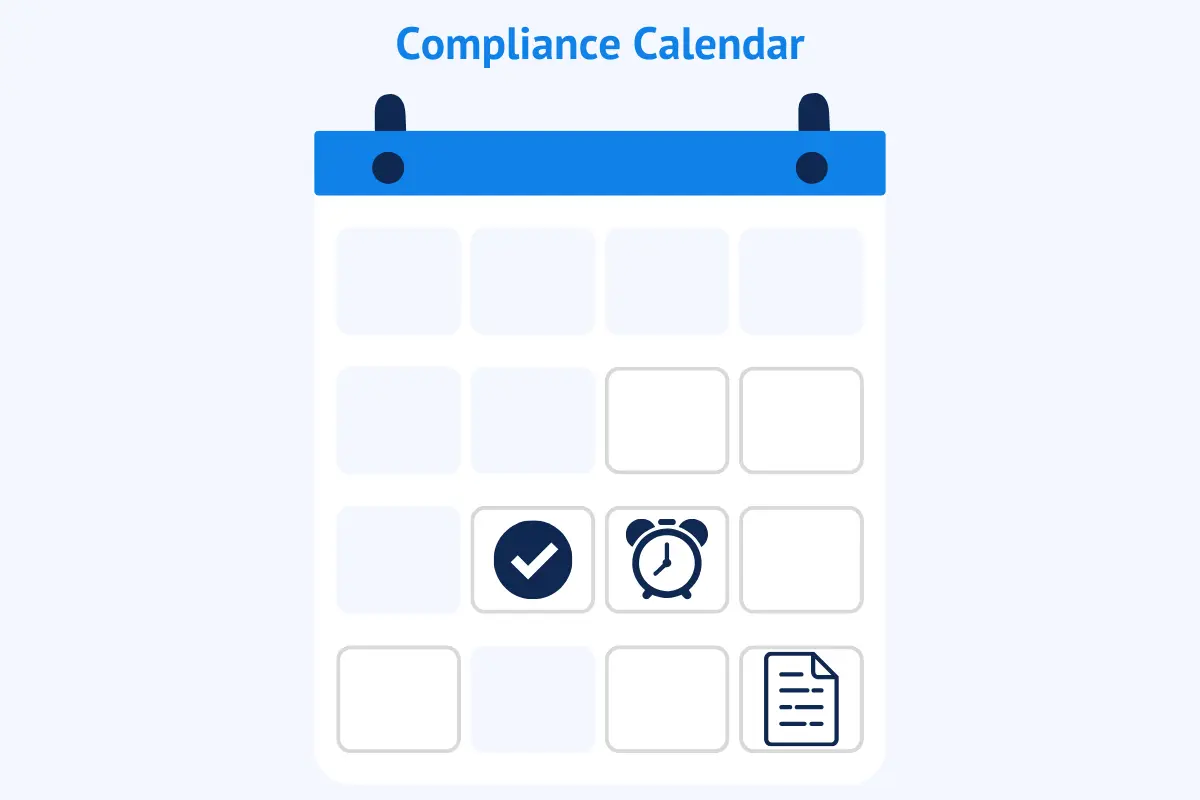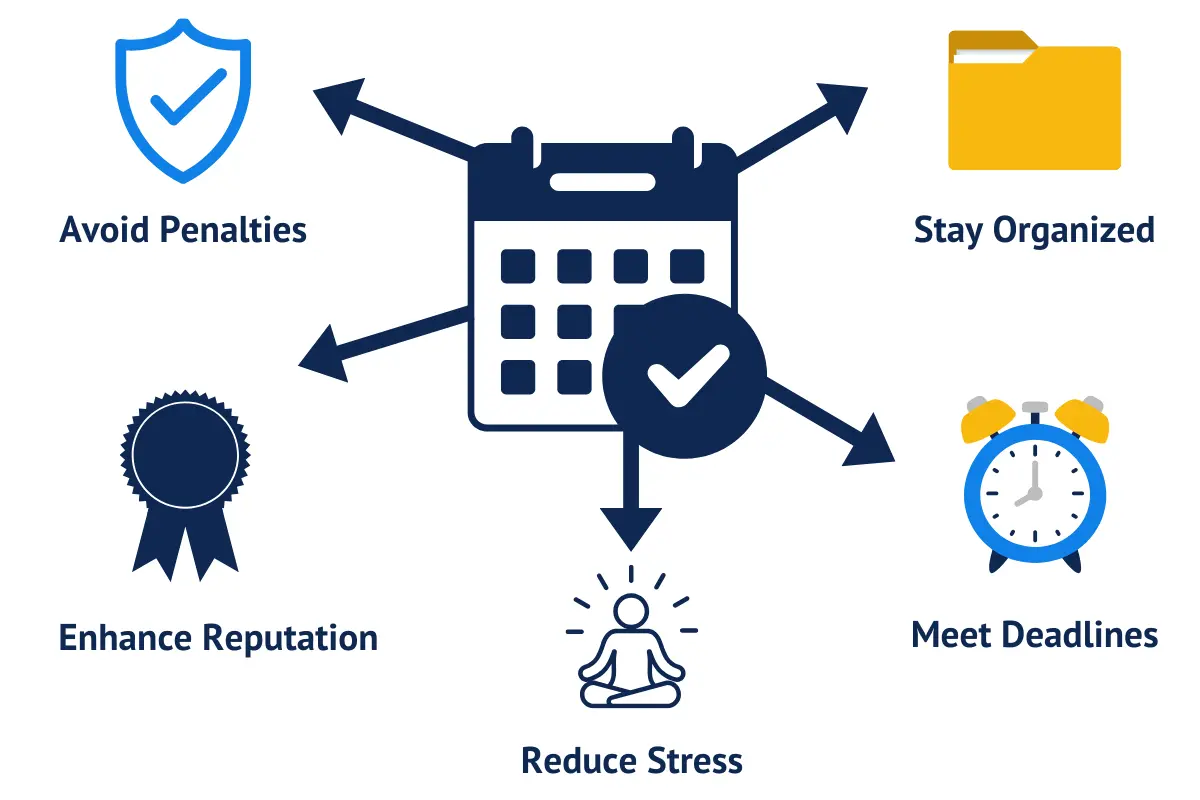Detailed Guide To Compliance Calendar

Compliance is more than just ticking boxes—it's the backbone of a sustainable business. Every company is responsible for establishing clear policies and overseeing compliance processes to ensure all legal and regulatory obligations are met. Yet, with countless deadlines for tax filings, license renewals, and industry-specific requirements, staying on top of compliance can feel overwhelming. Business owners often find themselves juggling multiple requirements, each with its own set of deadlines and consequences.
A compliance calendar transforms this complexity into a manageable system, acting as your central hub for tracking every critical deadline. By organizing obligations into a clear, actionable schedule, businesses can minimize risk, avoid costly penalties, and operate with confidence.
In this guide, we'll show you how to leverage a compliance calendar to keep your business protected, organized, and always ahead of regulatory requirements.
Key Takeaways
-
A compliance calendar is essential for tracking deadlines, reducing risk, and avoiding costly penalties.
-
Centralized compliance management improves accountability, audit readiness, and operational efficiency
-
Regular updates, clear task ownership, and digital tools help maintain effective compliance processes
-
Proactive compliance management supports business growth, reputation, and stress-free operations
-
Partnering with trusted providers like InCorp can simplify compliance and keep your business organized
Understanding a Compliance Calendar
A compliance calendar is a comprehensive roadmap that helps organizations capture and manage every compliance-related task and legal requirement throughout the year. This essential tool details what needs to be done, who is responsible, required documentation, and key deadlines, enabling organizations to systematically manage risks and ensure compliance with applicable regulations.
Effective compliance management systems rely on a structured corporate compliance framework that integrates risk assessment, policy management, and regulatory tracking. Such systems help organizations coordinate compliance activities, adhere to internal policies, and respond proactively to evolving regulations. For example, healthcare organizations track tasks like medical license renewals and audits related to the Health Insurance Portability and Accountability Act (HIPAA), while manufacturing companies focus on environmental permits and safety certifications.
Organizations operating across multiple jurisdictions face various risks, including data privacy challenges and social engineering threats targeting corporate social accounts. Managing these risks requires a compliance calendar that adapts to diverse regulatory environments and supports ongoing compliance efforts.
InCorp's experience shows that businesses benefit from proper corporate documentation and organizational tools—such as corporate kits and seals—to support their compliance processes. However, maintaining compliance can be costly and time-consuming, especially for small businesses. According to the U.S. Chamber of Commerce, "69% of small businesses say they spend more per employee to comply with regulations than larger competitors. About two in five (44%) small businesses say they outsource compliance tasks, further demonstrating the financial burden these tasks can put on a small business owner."
A well-maintained compliance calendar is a foundational element of effective compliance management systems, helping organizations reduce risk, streamline policy management, control compliance costs, and ensure regulatory obligations are met consistently across all operations.
The Importance of a Compliance Calendar & Why It Matters
Modern businesses face increasing regulatory demands that require proactive and effective compliance management, as well as comprehensive risk mitigation planning. As Simon Moore of BIE Executive notes, "As regulations become more global and multifaceted, many CFOs are struggling to keep up with the demands of proactive compliance management. And, if finance leaders are behind then the company certainly will be."
In this evolving landscape, a compliance calendar serves as an essential tool that helps organizations stay compliant with changing regulations by continuously monitoring and managing various risks.
Effective compliance management means developing and implementing risk mitigation strategies that enable organizations to identify, evaluate, and address risks before they escalate. With a robust risk mitigation plan, organizations can reduce risks to acceptable levels, ensuring continuous adherence to legal requirements. This systematic approach not only streamlines operations but also helps organizations adapt to new regulations and maintain operational efficiency and continuous compliance.

Prevents Missed Deadlines and Penalties
One of the most critical benefits of a compliance calendar is deadline protection through systematic risk mitigation and regular risk assessments. By continuously monitoring key deadlines, organizations can prevent regulatory penalties—missed tax filings can trigger escalating financial risks, while license violations may disrupt business continuity. A well-structured compliance program helps identify and address potential risks before they develop into significant issues, supporting ongoing compliance and operational efficiency.
Reduces Compliance-Related Stress
Regulatory uncertainty can create ongoing anxiety and hinder effective decision-making throughout an organization. Comprehensive compliance management systems address this challenge by giving business leaders complete visibility into regulatory requirements. With this clarity, leaders can make informed decisions and implement risk mitigation strategies that ensure ongoing compliance and reduce organizational risk.
Strengthens Internal Accountability
Clear task ownership within compliance management systems eliminates confusion and strengthens internal accountability across the entire organization. By using a top-down approach to assign compliance activities, organizations can more effectively manage risks and implement useful control risk measures, ensuring continuous compliance at every level.
Enhances Business Reputation and Trust
Consistent regulatory compliance enhances credibility with stakeholders and supports effective risk avoidance strategies. Organizations that prioritize compliance benefit from smoother audits and quicker permit approvals, which in turn contribute to business continuity and overall risk reduction.
Supports Audit and Inspection Readiness
Well-organized compliance management systems support audit and inspection readiness by maintaining comprehensive records of all compliance activities. Centralized platforms streamline documentation and ensure that compliance data is easily accessible when preparing for audits. This approach demonstrates systematic risk management, which regulatory agencies value during regular audits and inspections.
Improves Operational Planning and Workflow
Integrating compliance requirements with operational planning helps increase efficiency by supporting workflow automation and preventing process conflicts. When regulatory demands are visible through automated workflows, managers can allocate resources effectively and avoid scheduling disruptions. Automating document reviews, scheduling regular audits, and tracking training completion all benefit from integration with operational planning. Such activities further streamline compliance efforts.
Key Benefits of Implementing a Compliance Calendar
Implementing a compliance calendar offers significant value, supporting business success and growth while establishing effective risk management frameworks. By establishing clear compliance processes, organizations can better protect corporate data by consistently enforcing data privacy and security measures, thereby reducing the risk of breaches. Many organizations employ a top-down approach, with business leaders at the executive level setting compliance standards and fostering a culture of accountability.

Minimizes Legal and Financial Risk
Risk reduction is a primary benefit of systematic compliance management and proactive risk mitigation strategies. By implementing comprehensive compliance processes, organizations can avoid the escalating financial risks and legal liabilities associated with non-compliance.
For example, missing a tax deadline or failing to renew a business license can result in hefty fines or even legal action, costly setbacks that a proactive compliance program helps prevent. Additionally, some organizations use insurance policies to transfer specific risks, further strengthening their overall risk management framework.
Boosts Efficiency and Productivity
Scheduled compliance activities enable better resource allocation and proactive risk mitigation planning, directly supporting operational efficiency. By using automated workflows and centralized platforms, teams can prepare systematically rather than scrambling to handle emergency compliance situations. This not only reduces manual errors and repetitive tasks but also frees up staff to focus on higher-value work, leading to increased productivity and fewer costly mistakes.
This means instead of spending hours tracking down documentation or responding to last-minute regulatory requests, employees can quickly access all the information they need in one place, allowing operations to run smoothly and consistently.
Promotes Organizational Transparency
Centralized compliance management provides visibility across departments, improving coordination throughout the entire organization. This transparency enables business leaders to assess various risks and implement effective control measures, thereby supporting continuous improvement initiatives.
For instance, when everyone has access to up-to-date compliance information, departments can quickly identify potential issues, share insights, and collaborate on solutions, reducing the chance of misunderstandings or missed obligations.
Encourages Proactive Compliance Management
Moving from reactive to proactive approaches represents a fundamental improvement in risk management capabilities. Risk mitigation strategies become standard practice, enabling businesses to anticipate new regulations and implement continuous improvement while maintaining ongoing compliance. This proactive stance allows compliance teams to monitor industry trends and prepare updates ahead of regulatory changes, reducing stress and minimizing the risk of costly oversights.
Enhances Team Accountability
A straightforward assignment of compliance requirements eliminates ambiguity and improves follow-through. Regular monitoring through compliance and risk management software helps identify workload imbalances and ensures adequate risk management coverage. When team members understand exactly what they're responsible for and can track their progress in real time, accountability increases, and essential compliance tasks are less likely to fall through the cracks.
Simplifies Audit Preparation
Organized compliance processes make preparing for audits much easier by showing a clear, systematic approach to managing risks. Well-maintained documentation provides solid evidence of good faith compliance efforts during audits, which can lead to more favorable results. During an audit, having all documentation organized in advance means teams can answer auditor questions quickly and confidently, turning what's often a stressful event into a manageable, routine process.
Facilitates Scalability and Growth
Structured compliance management systems support business expansion by making it easier to handle growing regulatory requirements across multiple regions or markets. Scalable risk management frameworks adapt as a company becomes more complex, allowing organizations to confidently enter new markets or introduce new products without being overwhelmed by compliance challenges. This approach enables teams to focus on growth opportunities, knowing their compliance processes can keep pace with the changing environment.
Best Practices for Maintaining a Compliance Calendar
Effective compliance management requires systematic approaches ensuring accuracy while supporting comprehensive risk mitigation planning. Organized compliance calendar management maximizes value while minimizing maintenance burden. Organizations can leverage other resources such as compliance software, risk management software, or external consultants to support their compliance calendar management.
Regularly Update the Calendar
Regulatory requirements change frequently, making continuous compliance monitoring and regular risk assessments essential for maintaining compliance across all operations. Quarterly reviews should examine all calendar entries, while monthly updates address immediate changes in compliance regulations and regulatory demands.
Use Digital Tools and Automation
Compliance software and risk management software provide significant advantages through automated workflows and integration capabilities that enhance operational efficiency. These platforms can automate manual tasks such as risk assessments, evidence collection, monitoring, and reporting, which minimizes errors and saves time. Many solutions also offer regulatory update services and centralized platform access, assisting organizations in managing risks more effectively and staying current with evolving compliance requirements.
Assign Clear Task Ownership
Each compliance requirement should have designated responsible parties to ensure the effective implementation of risk mitigation strategies. Clear task ownership involves assigning specific individuals or teams to each compliance obligation and equipping them with the necessary training and resources for successful risk management. This approach reduces ambiguity, strengthens accountability, and helps ensure that nothing slips through the cracks.
Integrate with Broader Business Operations
Compliance management is most effective when integrated with overall business operations and planning systems. This approach prevents scheduling conflicts, ensures that resources are allocated appropriately for compliance activities, and helps control risk without disrupting day-to-day workflows. By aligning compliance efforts with broader business goals, organizations can maintain operational efficiency while meeting regulatory requirements.
Maintain Centralized Access
Relevant team members should have easy access to compliance information through centralized platform solutions. Centralized access control consolidates permissions and authentication management within a single system, making it easier to enforce consistent security policies and simplify administration. Role-based access ensures that users only see the information necessary for their roles, supporting effective risk management and compliance processes.
Conduct Regular Risk Assessments and Internal Reviews
Regular audits help identify missed compliance tasks and process inefficiencies, supporting both continuous improvement initiatives and comprehensive risk assessments. Internal reviews also create opportunities to gather user feedback and pinpoint areas for enhancement, resulting in stronger risk management and more effective compliance processes.
Document Changes and Compliance Activities
Maintaining comprehensive records creates valuable audit trails that support future planning and effective risk mitigation. Documentation should include the rationale for any changes, impact assessments, and instances of risk acceptance, along with detailed reasoning. Thorough recordkeeping not only demonstrates compliance during audits but also helps organizations learn from past decisions and continuously improve their compliance processes.
The Role of a Compliance Calendar in Business Success
Compliance calendars go beyond basic deadline tracking—they become strategic business tools that support sustainable growth through comprehensive risk management. Organizations that excel at compliance management gain a competitive edge by proactively implementing effective risk avoidance strategies.
According to SCORE, a nonprofit organization dedicated to mentoring and educating entrepreneurs:
"Legal compliance isn't just about avoiding penalties; it's a strategic framework that enhances reputation, mitigates risks, and ensures sustainable growth."
A compliance calendar is a key component in executing a risk avoidance strategy, as it ensures that regulatory deadlines are proactively addressed and nothing is overlooked.
FAQs
Can a compliance calendar be industry-specific?
Yes, compliance management systems should be tailored to specific regulatory environments and industry standards to effectively manage risks. Healthcare, finance, and manufacturing have unique requirements that require specialized risk assessment and compliance processes.
How far in advance should compliance deadlines be scheduled?
Deadlines should be scheduled as soon as they are known, with multiple reminder intervals—such as 30, 14, and 7 days in advance—to ensure there is enough time for preparation and effective risk mitigation. This proactive approach helps prevent missed deadlines and supports thorough documentation and compliance processes.
Is a compliance calendar useful for startups or only for large organizations?
A compliance calendar is useful for both startups and large organizations. Startups benefit by establishing good compliance habits early and avoiding costly penalties, while larger organizations use compliance calendars to coordinate activities across multiple departments and manage complex requirements efficiently.
What are the risks of not having a compliance calendar?
Not having a compliance calendar exposes businesses to significant risks, including financial penalties, legal liabilities, operational disruptions, and reputational damage due to missed deadlines or non-compliance. Without systematic tracking, companies are more likely to overlook important filings, licenses, or renewals, leading to costly fines and lost revenue opportunities. Poor compliance management also increases stress and makes it harder to implement effective risk mitigation measures.
How often should a compliance calendar be reviewed or audited?
A compliance calendar should be reviewed or audited at least quarterly or biannually to ensure all current obligations are captured and nothing is overlooked due to regulatory changes. Regular audits help maintain continuous compliance and adapt to evolving business or legal requirements.
Stay Ahead of Deadlines with Expert Compliance Support
Don't let regulatory complexity hold your business back. InCorp's professional compliance support removes the guesswork, keeps you organized, and helps your business stay on top of important filing deadlines—all while reducing compliance-related stress.
Ready to move from last-minute scrambling to confident, proactive compliance? InCorp's experts provide reliable tools like compliance calendars, managed reports, and automated reminders to help you avoid costly mistakes and stay audit-ready.
See how InCorp can help protect your business and fuel your growth with systematic compliance management and dependable, ongoing support.
Share This Article:
Stay in the know!
Join our newsletter for special offers.